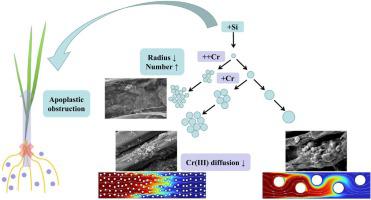Journal of Hazardous Materials ( IF 12.2 ) Pub Date : 2023-05-26 , DOI: 10.1016/j.jhazmat.2023.131720 Zhihao Pang 1 , Yuchao Mei 1 , Nina Nikolic 2 , Miroslav Nikolic 2 , Tingqiang Li 1 , Hongyun Peng 1 , Yongchao Liang 1

|
Trivalent chromium [Cr(III)] is a threat to the environment and crop production. Silicon (Si) has been shown to be effective in mitigating Cr(III) toxicity in rice. However, the mechanisms by which Si reduces Cr(III) uptake in rice are unclear. Herein, we hypothesized that the ability of Si to obstruct Cr(III) diffusion via apoplastic bypass is related to silicic acid polymerization, which may be affected by Cr(III) in rice roots. To test this hypothesis, we employed hydroponics experiments on rice (Oryza sativa L.) and utilized apoplastic bypass tracer techniques, as well as model simulations, to investigate 1) the effect of Si on Cr(III) toxicity and its obstruction capacity via apoplastic bypass, 2) the effect of Cr(III) on silicic acid polymerization, and 3) the relationship between the degree of silicic acid polymerization and its Cr(III) obstruction capacity. We found that Si reversed the damage caused by Cr(III) stress in rice. Si exerted an obstruction effect in the apoplast, significantly decreasing the share of Cr(III) uptake via the apoplastic bypass from 18% to 11%. Moreover, Cr(III) reduced silica particles' radii and increased Si concentration in roots. Modeling revealed that a 5-fold reduction in their radii decreased the diffusion of Cr(III) in apoplast by approximately 17%. We revealed that Cr(III) promoted silicic acid polymerization, resulting in the formation of a higher number of Si particles with a smaller radius in roots, which in turn increased the ability of Si to obstruct Cr(III) diffusion. This negative feedback regulatory mechanism is novel and crucially important for maintaining homeostasis in rice, unveiling the unique role of Si under Cr(III) ion stress and providing a theoretical basis for promoting the use of Si fertilizer in the field.
中文翻译:

从促进聚集到增强阻碍:硅减轻水稻三价铬毒性的负反馈调节机制
三价铬 [Cr(III)] 对环境和农作物生产构成威胁。硅 (Si) 已被证明可以有效减轻大米中的 Cr(III) 毒性。然而,Si 减少水稻对 Cr(III) 吸收的机制尚不清楚。在此,我们假设Si通过质外体旁路阻碍Cr(III)扩散的能力与硅酸聚合有关,这可能受到水稻根部Cr(III)的影响。为了验证这一假设,我们对水稻(Oryza sativa)进行了水培实验L.) 并利用质外体旁路示踪技术以及模型模拟来研究 1) Si 对 Cr(III) 毒性及其通过质外体旁路的阻塞能力的影响,2) Cr(III) 对硅酸的影响聚合度,3)硅酸聚合度与其Cr(III)阻隔能力之间的关系。我们发现硅逆转了水稻中 Cr(III) 胁迫造成的损害。Si 在质外体中发挥阻碍作用,显着降低通过质外体旁路吸收 Cr(III) 的比例,从 18% 降至 11%。此外,Cr(III) 减小了二氧化硅颗粒的半径并增加了根中硅的浓度。模型显示,半径减少 5 倍,质外体中 Cr(III) 的扩散减少约 17%。我们发现 Cr(III) 促进硅酸聚合,导致根部形成更多半径更小的 Si 颗粒,从而增加 Si 阻碍 Cr(III) 扩散的能力。这种负反馈调节机制是新颖的,对于维持水稻体内稳态至关重要,揭示了硅在Cr(III)离子胁迫下的独特作用,为推广硅肥在田间的使用提供了理论依据。











































 京公网安备 11010802027423号
京公网安备 11010802027423号